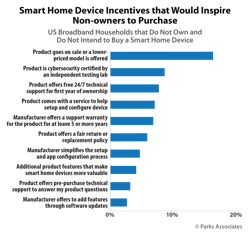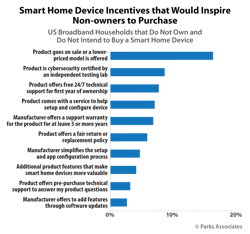Despite the proliferation of available smart home devices and services, as well as numerous escalating promotions, the adoption rate for many smart home products has remained consistent over the past four years.
As manufacturers and service providers are eager to understand what they must do to make significant gains in sales and revenue, Parks Associates research reveals that among the 42% of U.S. broadband households who do not own and do not plan to buy a smart home device, 17% admit they would likely buy a device if the cost were lower.
Capturing these consumers at the right price point would add 7.9 million more households to the population of smart home owners.
Price is a major barrier to smart home adoption, especially among younger heads of household, who recognize the value but feel priced out of the market. Reducing price while still offering important features is a valuable strategy, with WYZE and Yi Home taking this route. Additionally, Nest, eufy, and Blink have all released lower-priced versions of their products that include fewer features at a more affordable price.
In Parks Associates’ Q4 2020 survey, affordability ranks as the most important purchase consideration among purchaseOffering discounts, bundles of products, or the option for consumers to purchase a lower-priced model of existing smart home devices increases device adoption. Discounts and bundling of a common smart device such as a smart speaker with smart plugs, smart light bulbs, or smart thermostats have been used to introduce the smart home experience. Offering lower-priced models of existing products with fewer features also addresses those prospects that want the smart home experience but are not interested in having all possible features.
Selling on Value
As familiarity with devices continues to increase, value perception has not. More than 50% of U.S. broadband households who do not own or intend to purchase a smart home device report they do not see any benefits to smartTherefore, convincing consumers of the value of smart home devices and the benefits that come from owning these devices remains the most important messages necessary to increase adoption. Messaging that highlights strong product value helps overcome price sensitivity and counters the perceived lack of a viable value proposition.
With the increasing number of privacy issues related to smart home devices, implementing additional security and privacy measures are also keys to increasing adoption. Given that manufacturers’ data security and privacy claims tend to be similar, attention must truly make data security and privacy as a core brand attribute for differentiation. Partnerships with solution providers and third-party cybersecurity testing and certification services are emerging as ways for manufactures to make a claim in hopes of overcoming this barrier.
Positive consumer onboarding experiences and ongoing technical support solutions with connected home products and systems are critical to brand success. Focusing on simple device setup, helpful onboarding and ongoing support, will help those that cite fear of technical issues feel more confident about purchasing smart home devices. Positive successful installation experiences also have a significant impact on product return rates and brand loyalty.
Patrice Samuels is a Senior Analyst for market research firm Parks Associates (www.parksassociates.com). Visit their website to learn more about market barriers, consumer fears and strategies for addressing or alleviating their concerns in order to expand sales.
About the Author

Patrice Samuels
Patrice Samuels is a Senior Analyst for market research firm Parks Associates (www.parksassociates.com).


